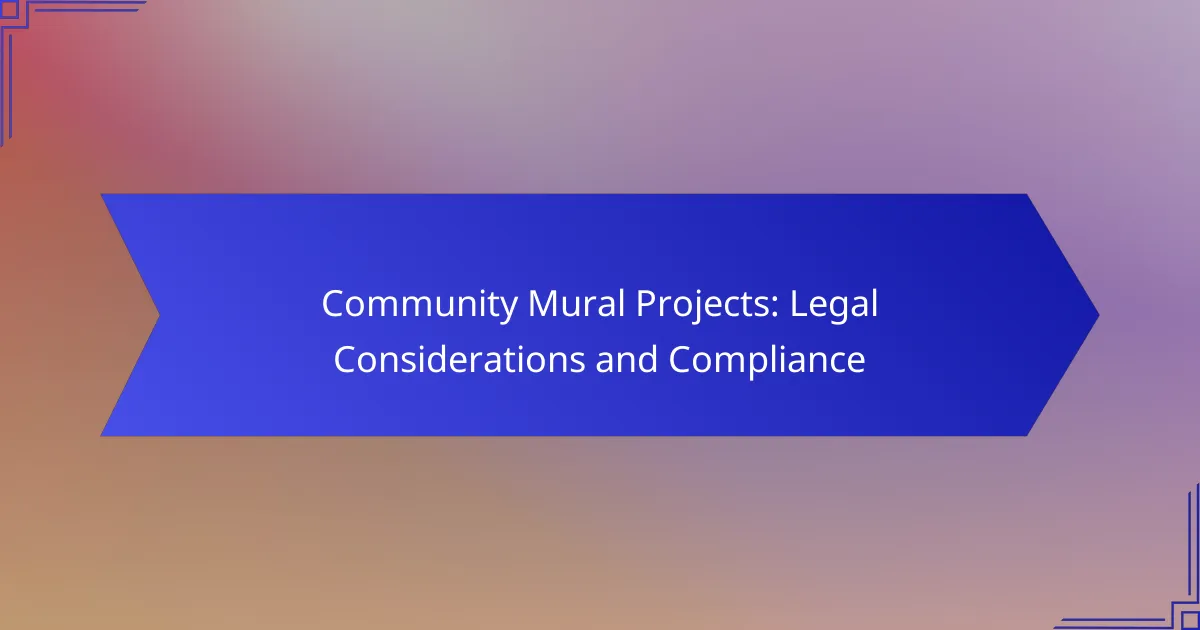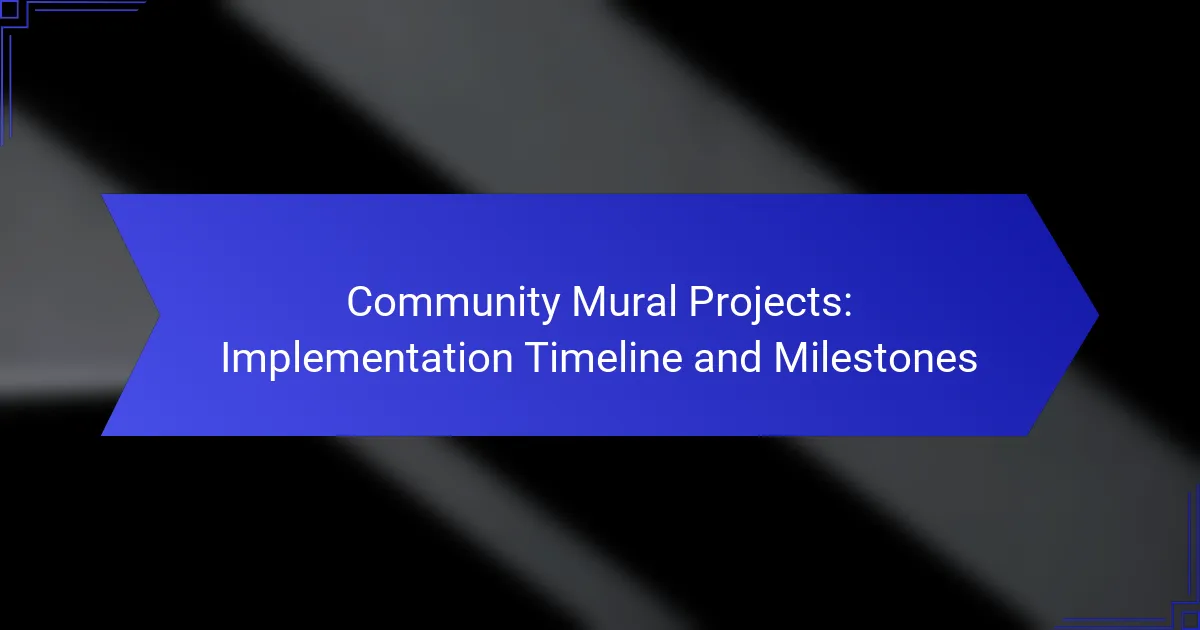Community mural projects require careful budgeting to cover essential costs such as materials, labor, permits, and maintenance. A detailed cost breakdown helps in understanding these financial components, which is crucial for effective budgeting and securing funding. Various funding sources, including government grants, nonprofit sponsorships, and crowdfunding, can be explored to ensure the project’s financial viability and community support.
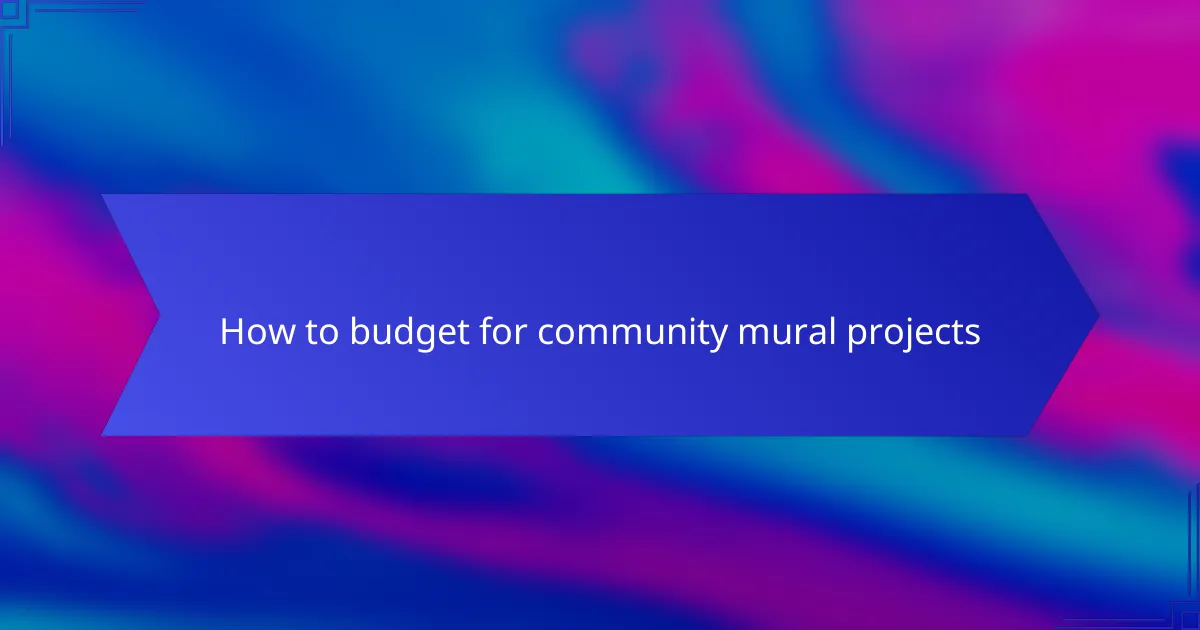
How to budget for community mural projects
Budgeting for community mural projects involves estimating costs for materials, labor, permits, and ongoing maintenance. A well-structured budget ensures that the project remains financially viable and meets community expectations.
Estimate material costs
Material costs typically include paint, brushes, scaffolding, and protective gear. Depending on the size and complexity of the mural, these expenses can range from a few hundred to several thousand dollars.
Consider sourcing materials locally to reduce shipping costs and support local businesses. Additionally, bulk purchasing can often lead to discounts, so plan ahead to maximize savings.
Calculate labor expenses
Labor expenses encompass the costs of artists, assistants, and volunteers. Rates can vary widely; professional muralists may charge between $20 to $100 per hour, while community volunteers may offer their time for free.
Factor in the number of hours required for design, preparation, and painting. It’s wise to include a buffer in your budget for unexpected labor needs or delays.
Include permits and fees
Permits and fees are often necessary for mural projects, especially in urban areas. Check with local authorities regarding regulations, as costs can range from minimal fees to several hundred dollars depending on the location.
Ensure that you allocate time for the permitting process, as it can take weeks or even months. Failure to secure the proper permits can lead to project delays or fines.
Account for promotional costs
Promotional costs can enhance community engagement and support for the mural project. This may include flyers, social media advertising, or events to unveil the mural, which can collectively cost several hundred dollars.
Consider leveraging local media and community groups to promote the project at little to no cost. Engaging the community through social media can also help reduce promotional expenses.
Consider maintenance expenses
Maintenance expenses are crucial for preserving the mural’s integrity over time. This may involve periodic touch-ups, cleaning, or protective coatings, which can add up to a few hundred dollars annually.
Establish a maintenance plan early on, including a budget for future upkeep. Engaging the community in maintenance efforts can also foster a sense of ownership and responsibility for the mural.
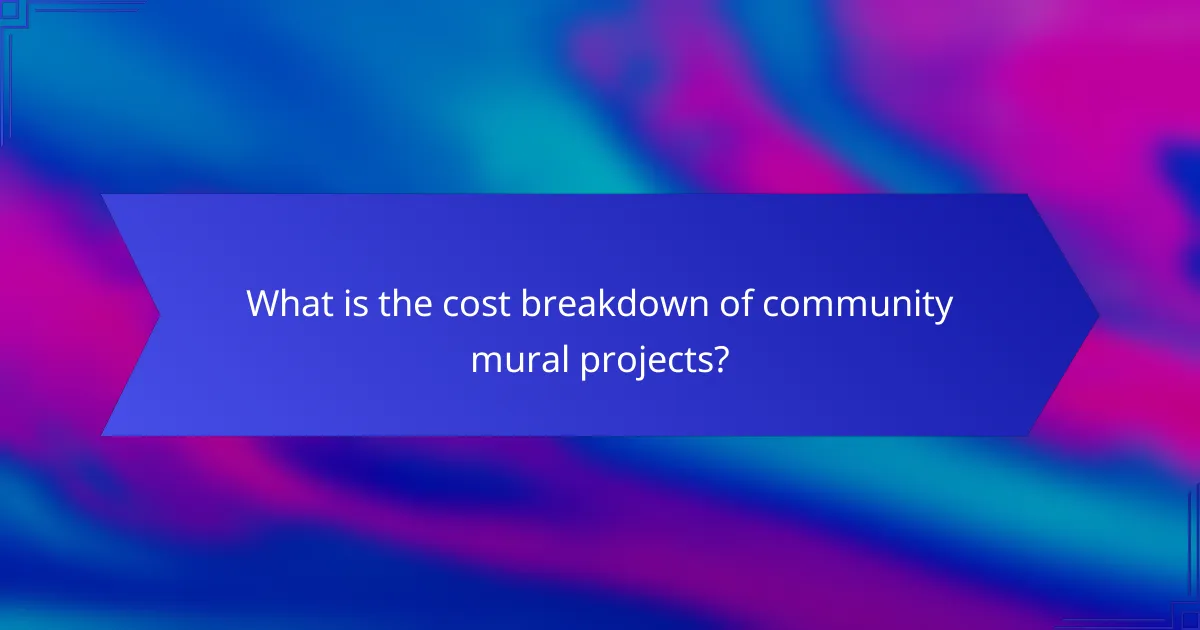
What is the cost breakdown of community mural projects?
The cost breakdown of community mural projects typically includes material costs, labor expenses, permits, and marketing. Understanding these components helps in budgeting effectively and securing necessary funding.
Material cost percentages
Material costs usually account for about 30-50% of the total project budget. This includes paint, brushes, scaffolding, and protective coatings. Selecting high-quality materials can enhance durability but may increase initial expenses.
For example, a mural project with a budget of $10,000 might allocate $3,000 to $5,000 for materials. It’s essential to source materials from local suppliers to potentially reduce shipping costs and support the community.
Labor cost averages
Labor costs generally represent 40-60% of the overall budget. This includes payments for artists, assistants, and project managers. Rates can vary significantly based on experience and location, with professional muralists charging anywhere from $20 to $100 per hour.
For a project budgeted at $10,000, labor could range from $4,000 to $6,000. Hiring local artists can foster community engagement and may offer cost savings compared to hiring from outside the area.
Permit and fee ranges
Permits and fees can vary widely, typically ranging from $100 to $1,000 depending on local regulations. Some municipalities may require specific permits for public art, which can add to the overall cost. It’s crucial to check with local authorities early in the planning process to avoid unexpected expenses.
In some cases, community organizations may assist with navigating the permitting process, potentially reducing costs and streamlining approvals.
Marketing budget allocation
Marketing for mural projects usually requires about 5-15% of the total budget. This can include promotional materials, social media campaigns, and community engagement events. Effective marketing helps raise awareness and attract visitors to the mural, enhancing its impact.
For a $10,000 project, allocating $500 to $1,500 for marketing can significantly boost community involvement. Consider leveraging local media and social platforms to maximize outreach without overspending.
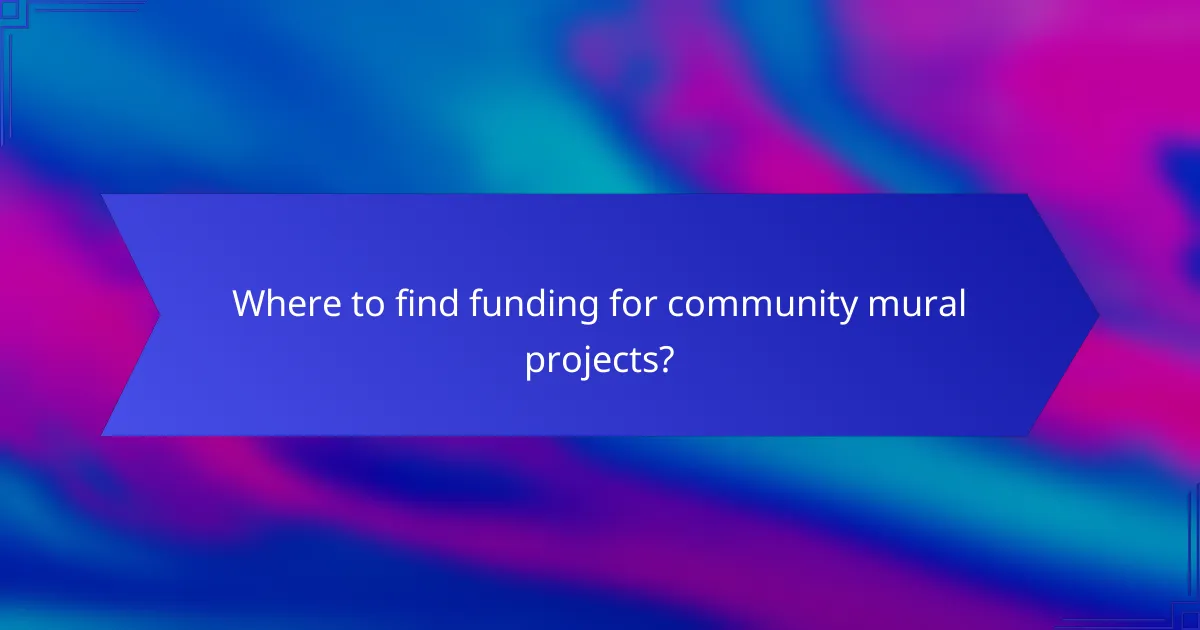
Where to find funding for community mural projects?
Funding for community mural projects can be sourced from various avenues, including local government grants, nonprofit sponsorships, crowdfunding platforms, and corporate partnerships. Each option has its own requirements and benefits, making it essential to explore multiple funding sources to secure the necessary budget.
Local government grants
Local government grants are often available to support public art initiatives, including murals. These grants can vary widely in amount, typically ranging from a few hundred to several thousand dollars, depending on the municipality and the project’s scope.
To apply, check your city or county’s arts council or community development department for available programs. Be prepared to outline your project’s goals, community impact, and budget to increase your chances of receiving funding.
Nonprofit organization sponsorships
Many nonprofit organizations focus on community development and the arts, making them potential sponsors for mural projects. These organizations may provide funding, resources, or volunteer support, which can significantly reduce overall project costs.
Research local nonprofits that align with your mural’s theme or community goals. Craft a compelling proposal that highlights how your project complements their mission and benefits the community to secure their support.
Crowdfunding platforms
Crowdfunding platforms like Kickstarter or GoFundMe allow individuals and groups to raise funds directly from the community. This method can be particularly effective for mural projects, as it engages local residents and fosters a sense of ownership.
When using crowdfunding, set a realistic funding goal and create an engaging campaign page with visuals and a clear description of the project. Promote your campaign through social media and local networks to maximize reach and contributions.
Corporate sponsorship opportunities
Corporate sponsorships can provide substantial funding for community mural projects, especially from businesses that want to enhance their community image. Companies may offer financial support, materials, or in-kind services in exchange for brand visibility on the mural.
Approach local businesses that align with your project’s values and audience. Prepare a sponsorship proposal outlining the benefits for the company, such as promotional opportunities and community goodwill, to encourage their investment in your mural project.
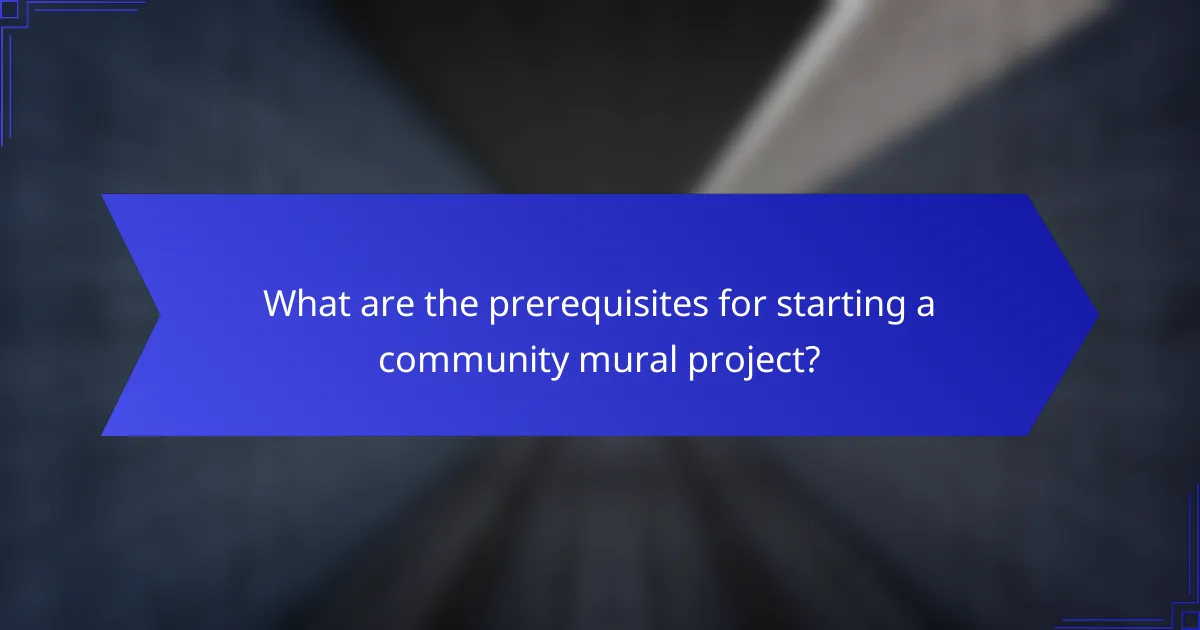
What are the prerequisites for starting a community mural project?
To start a community mural project, you need to ensure community engagement, select suitable artists, and secure site approval. These prerequisites help establish a solid foundation for the project, ensuring it meets local needs and regulations.
Community engagement requirements
Community engagement is essential for a successful mural project. This involves gathering input from local residents and stakeholders to understand their vision and preferences for the mural. Organizing meetings, workshops, or surveys can facilitate this process.
Effective engagement can also help build support and enthusiasm for the project, which may lead to increased funding and volunteer participation. Aim for diverse representation to ensure the mural reflects the community’s identity and values.
Artist selection criteria
Selecting the right artist is crucial for the mural’s quality and relevance. Consider criteria such as the artist’s experience with community projects, their portfolio, and their ability to collaborate with local stakeholders. Look for artists who demonstrate a strong understanding of cultural sensitivity and local themes.
It’s beneficial to involve community members in the selection process, allowing them to vote or provide feedback on artist proposals. This inclusion fosters a sense of ownership and connection to the final artwork.
Site approval processes
Securing site approval is a vital step in launching a mural project. This typically involves obtaining permission from property owners and local authorities, which may include submitting design proposals for review. Familiarize yourself with local regulations regarding public art and zoning laws.
In some areas, you may need to apply for permits or follow specific guidelines to ensure compliance. Start this process early, as approvals can take time, and be prepared to make adjustments to your design based on feedback from stakeholders or regulatory bodies.

How to choose the right location for a mural?
Choosing the right location for a mural is crucial as it affects visibility, community engagement, and overall impact. A well-placed mural can attract attention and foster a sense of pride among local residents.
Visibility and foot traffic
High visibility and foot traffic are essential for maximizing the exposure of a mural. Locations near busy streets, public transport hubs, or popular gathering spots tend to draw more viewers. Consider areas where people naturally congregate, such as parks, plazas, or shopping districts.
To evaluate foot traffic, observe the area at different times of day and week. Look for patterns in pedestrian movement and consider using local data on traffic counts if available. A mural in a high-traffic area can significantly enhance its reach and impact.
Community relevance
Community relevance is about ensuring the mural resonates with local culture and values. Engaging with residents to understand their stories, interests, and concerns can guide the mural’s theme and design. A mural that reflects the community’s identity fosters pride and ownership.
Consider collaborating with local artists or organizations to create a mural that speaks to the community’s history or aspirations. This connection can encourage community support and participation, making the project more successful and meaningful.









